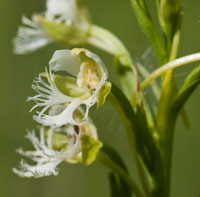Eastern prairie fringed-orchid
Scientific name: Platanthera leucophaea

Cover photo credit: © Josh Vandermeulen CC BY-NC
Status
Endangered
“Endangered” means the species lives in the wild in Ontario but is facing imminent extinction or extirpation.
Date added to the Species at Risk in Ontario List
The Eastern prairie fringed-orchid was already assessed as endangered when the Endangered Species Act took effect in 2008.
What it looks like
The Eastern Prairie Fringed-orchid is an impressive rare orchid that is native to Ontario. The plant has fringed white flowers (up to 3 cm wide), with a characteristic “lip” that serves as a landing platform for pollinating insects.
Each flower has a very deep “nectar spur” that contains lots of nectar, and which only large insects such as Hawkmoths with long probosci (mouthparts) can reach into.
Flowers open gradually, starting from the bottom of the stalk, and last for about ten days. A large plant may have flowers for a total of three weeks.
If you are watching the same plants from year to year, keep in mind that this orchid may not flower every year. In fact, the Eastern Prairie Fringed-orchid can lie dormant for several years in between flowering.
Where it lives
The Eastern Prairie Fringed-orchid grows in wetlands, fens, swamps and tallgrass prairie. It has been found in ditches and railroad rights of way.
Where it’s been found in Ontario
The species ranges from Ontario to Illinois, Wisconsin, Ohio, Kansas and further west to Nebraska. In Ontario, there are about 20 small populations in prairie habitat or fens in Simcoe, Essex and Lambton counties, and the municipality of Chatham-Kent.
It’s also found in tamarack swamps in the Bruce Peninsula and Ottawa area.
View a Larger version of this map (PDF)
What threatens it
As with other species at risk, habitat loss and destruction is a major concern. At one time, the species was probably much more common in the prairies of Walpole Island and the St. Clair River region but much of this habitat has been converted to farmland.
Also, the suppression of fire has reduced the number of suitable areas open for prairie plants. Declines in the populations of pollinating insects could also be contributing to a drop in orchid numbers.
Action we are taking
Endangered Species and their habitat are automatically protected
Recovery strategy
A recovery strategy advises the ministry on ways to ensure healthy numbers of the species return to Ontario.
Read the executive summary (February 18, 2010)
Read the recovery strategy (February 18, 2010)
Government response statement
A government response statement outlines the actions the government intends to take or support to help recover the species.
Read the government response statement (November 18, 2010)
Five-Year Review of Progress
A five-year review reports on progress made toward protecting and recovering a species, within five years of publishing a species’ government response statement.
Read the report on progress towards the protection and recovery of 13 species at risk, including Eastern Prairie Fringed-orchid (2015)
Habitat protection
A habitat regulation defines a species' habitat and many describe features (e.g., a creek, cliff, or beach), geographic boundaries or other unique characteristics.
Read the regulation (February 18, 2010)
What you can do
Report a sighting
- Report a sighting of an endangered animal or plant to the Natural Heritage Information Centre. Photographs with specific locations or mapping coordinates are always helpful.
Volunteer
- Volunteer with your local nature club or provincial park to participate in surveys or stewardship work focused on species at risk.
Be a good steward
- Private land owners have a very important role to play in species recovery. You may be eligible for stewardship programs that support the protection and recovery of species at risk and their habitats.
- Invasive species seriously threaten many of Ontario’s species at risk. To learn what you can do to help reduce the threat of invasive species, visit:
- Get involved with a habitat creation or restoration project in your area, or even on your own property. There are several management techniques that may be beneficial to the Eastern Prairie Fringed- orchid and other prairie species. These techniques include brush cutting, light grazing and controlled burns. Contact your local MNR office for information on management techniques and Stewardship projects in your area.
Report illegal activity
- Report any illegal activity related to plants and wildlife to
1-877-TIP-SMNR (847-7667) .
Quick facts
- International trade in orchids or their parts is controlled under CITES (Convention on International Trade in Endangered Species of Wild Fauna and Flora).
- This plant used to be widespread across the prairies, but has seriously declined throughout its historic range. Now, most of the world’s eastern prairie fringed-orchids are found in Ontario, along with Wisconsin and Ohio.
- Biologists recently discovered that the plant now known as the western prairie fringed-orchid is a different species than the Eastern Prairie Fringed-orchid.
